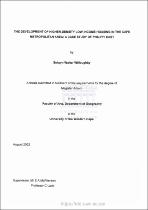| dc.description.abstract | Cape Town, like other South African cities, experiences phenomenal population growth as a result of natural increase, rural-urban and intra-urban migration. The population growth is exceeding the ability of all spheres of government to provide adequate housing. ln an attempt to rapidly respond to this crisis, subsidies are provided to qualifying beneficiaries to build free-standing dwellings. Simultaneously the Metropolitan Spatial Development Framework (MSDF) proposes a vision of an integrated functional city by prosing to increase residential densities in areas with the potential to improve the quality of life of the populations. The current low-income housing delivery programme is
thus conflicting with the vision of the MSDF. The aim of this research is to assess the feasibility, and to identify enabling mechanisms of building low-rise, higher-density low-income residential dwellings in Philippi East, a developing metropolitan node. Philippi East is the only node in the metropolitan area that is underdeveloped and located centrally within the poorest section of Cape Town. There are various concerns relating to housing within this area, however, the research focuses on three inter-related areas of concern, namely, access to appropriate urban land, appropriate housing density and access to finance. Central to the research is the identification of vacant land and the classification of the identified land in terms of its strategic value. The identification of strategic land determines the type of density that is appropriate and this in turn will establish the financial parameters for such a project. The research has found that in Philippi East, most of the appropriate land for higher-density low-income land is privately owned, and that current legalisation is focused on accelerating the release of publicly owned land. Thus, the legalisation will have little effect on the study area, where land is urgently needed for housing. Non Legislative measures have been identified as alternative mechanisms to secure private land for housing. Philippi East as a study area, is strategic in terms of the MSDF criteria, and therefore its residential densities could be developed to maximum recommendations. However, the contextual situating does not allow for high-rise developments, but rather a low-rise higher-density built form with a net dwelling density of approximately 100 d/ha. The research concludes that the short-term benefit of the subsidy is not complimenting the long term vision of the city, i.e. the subsidy amount by itself allows for the construction of a small freestanding dwellings that is perpetuating sprawl within Philippi
East. To construct low-rise higher-density dwellings larger than the current 10mz freestanding dwelling, additional finance is required. The research identifies that all spheres of government must play a pivotal role in mobilising additional public and private funding to ensure that the metropolitan node develops as intended by the city vision. | en_US |

